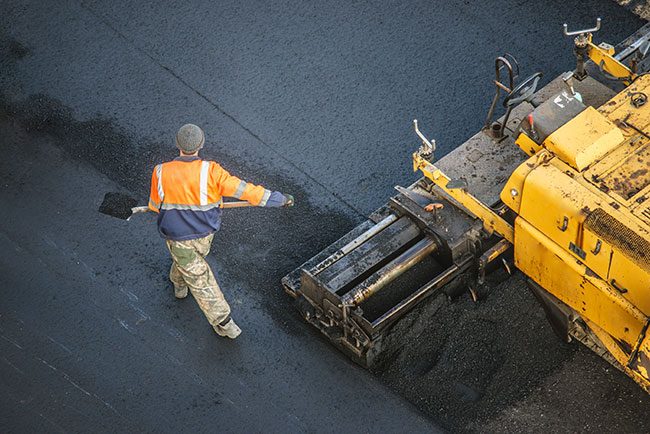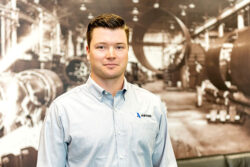
Features
Aggregates
Education
Event Reports
Roads & Paving
The road to net zero
A roundtable roadmap for the aggregates and roadbuilding industries’ fast-approaching future of decarbonization
April 9, 2024 By Jack Burton
 Photo: AdobeStock/By Artem
Photo: AdobeStock/By Artem Adaptation is on the agenda for the aggregates and roadbuilding industries.
This is due to Canada’s pledge to reduce carbon emissions to 40 per cent below 2005 levels by 2030 and ultimately reach net zero by 2050. These goals, and the changes they will bring to the sector, were the topic of Rock to Road’s inaugural virtual event, the Road to Net Zero.
Presented alongside exclusive sponsor ASTEC, the event opened with a keynote speech from Crestview Strategy and was followed by the Navigating Net Zero roundtable, which explored the changes these carbon reduction goals will bring and the strategies producers can use now to prepare for what’s to come.
Rock to Road brought together leading voices on sustainability in the aggregates and roadbuilding sectors to discuss these changes, including Mac Carmichael, senior director of sustainability and environment at Green Infrastructure Partners (GIP); Bill Gowdy, technical director of aggregates at SLR Consulting; Dr. Jon Makar, low carbon materials lead at the National Research Council (NRC); and Trevor Wagoner, product manager of sustainability at ASTEC.
Here is what the roundtable had to say:
RTR: Based on your experience, I’d like to try and get a snapshot of where you feel the roadbuilding and aggregate sectors currently stand when it comes to these goals.

Bill Gowdy, technical director of aggregates at SLR Consulting, is a geologist with more than 35 years of experience in all facets of aggregate assessment, including environmental monitoring, reclamation and securing regulatory approvals
BILL: Where we are in the aggregate industry is unique. We’re in the business of moving materials – a lot of what we do is transportation. Most of the greenhouse gas contributions I’ve seen are associated with the transportation behind getting these materials to market.
Deposits close to market are being depleted very, very quickly, and that’s going to increase the demand for transportation. The ability to have as much material as possible close to the market is going to become really critical. There are a lot of issues around permitting, public opposition, and resistance, but what it actually ends up doing is increasing greenhouse gas contributions.
TREVOR: The opportunity I’m seeing right now for us in the industry is a chance to really stay ahead of things and lead the conversation as the rules are being written. At your company, especially if you’re a producer, put together a program to track and manage energy consumption. Having that baseline established can inform you how to achieve a 10, 20, even 50 per cent reduction in greenhouse gases or your carbon footprint.
JON: One of the things to pay attention to is not just legislation, but where the procurement requirements are coming from. That’s where you’ll see the initial impact, because that’s where they’ll be looking to have their suppliers demonstrate that they’re cutting GHGs.
In many cases, it’s going to be much more about what the local people want. What Vancouver does is going to be different from what Toronto does, so it becomes about engaging with the people that you’re working with. If they’re buying your products or services, you need to know what their specific requirements are going to be based on where their market is.
MAC: It’s important for the industry to adapt now to start down that road to decarbonization. These requirements are not onerous, and we’ve already woven some of these ESG and sustainability considerations right into our operations.
In the construction materials world, we often look at ourselves as the temporary steward of a project, but we need to understand that what we do impacts the climate goals of both our customers and our stakeholders. We have to collaborate: we’re part of a larger network, and getting started with decarbonization now will keep us from being caught flat-footed and losing out on some opportunities for good work.
RTR: How do you see these changes affecting operations on a day-to-day level, and what are the consequences for professionals not sufficiently prepared for these changes?

As ASTEC’s product manager of sustainability, Trevor Wagoner works alongside the company’s Infrastructure Solutions group to help in developing innovative products that are economically and environmentally sustainable.
TREVOR: When it comes to asphalt and concrete plants, operations can have an overwhelming impact on the energy consumed during production, and that directly correlates to any effort to decarbonize operations. However, efforts to control those variables can take time, so professionals should start preparing now.
That means establishing the hardware and software used to track these metrics. You can manage what you can measure, and in this case, that’s operations and performance.
If you’re going to demonstrate a reduction, there’s often a requirement to establish a baseline built from annualized data. For that, you need a year’s worth of data to establish that baseline before beginning to make any reduction based off it.

Dr. Jon Makar is a material scientist with more than 25 years of experience in working with industrial and construction materials. He is currently serving the National Research Centre’s Construction Research Centre to help develop low carbon construction material alternatives
JON: It really is important to start getting those baseline numbers and establishing where you are. You want to be measuring what you’re doing, because at some point, someone is going to ask about them, and if you can’t demonstrate that you’ve improved, or even started, then you’re going to run into trouble.
Tracking, ideally in a form that is third-party validated, is going to be critical, whatever your role in the construction industry is. You’ll need to demonstrate what your carbon impact is, and that’s only possible if someone is doing a calculation on the whole project.
MAC: The approach to when and how we decarbonize will impact how we procure equipment and upgrade our plant assets. We’re going to see an increase in cost just from carbon pollution pricing: it’s $65 a ton right now, but that will increase to $170 in 2030. So suddenly, your cost of operation and equipment changes, unless you get on the path forward right now. If you don’t, you’re going to be stuck behind the eight-ball in terms of cost increases, and it will be too pricey to make the necessary operational changes in such a short period of time.
BILL: As Jon mentioned, it’s also going to affect the procurement side of things. Those buying your product will want to know its associated carbon footprint, because they’re putting that product into a road or a building project, and they need to know the environmental impact of their project. You’ve got to do that accounting at an early stage of the game, otherwise you won’t be able to compete or sell into the market without having that information.
Where is the sector’s current level of knowledge and preparedness on these issues, and how far away are we from where you feel we should be?
JON: Trying to find the answer to that question is part of what I do. For this industry, it really comes down to what the material is, and what it takes to get it in terms of energy.
Even still, there’s knowledge that needs to be built up along the supply chain to make sure everyone is on the same page. It’s getting ahead of the curve that will close the gap, and make sure that organizations can discuss this topic from the same perspective.

With a background in geological engineering and environmental consulting firms, Mac Carmichael currently serves the construction, construction materials and solid waste industry as Green Infrastructure Partners’ senior director of sustainability and environment.
MAC: It shouldn’t be surprising that we’re behind other industrial sectors. I don’t think that’s a negative thing, but to be expected. The major focus for decarbonization is on transportation, energy and building construction, but the thing is, we service those sectors.
That means we need to align our thinking with our customers and suppliers in those sectors, and that happens when we integrate sustainability and talks of decarbonization into our leadership. They need to be able to include decarbonization into their strategy and walk the talk, and from there, educate teams internally. I believe sustainability efforts have to be championed across the company, rather than being the responsibility of a single, specialized department.
TREVOR: A lot of PR efforts in this industry may lag behind others, but what’s been really impressive to me is how quickly I’ve seen producers latch onto this idea once they get a handle of what’s needed. I haven’t seen a lot of green-washing, so to speak, coming out of our industry. A lot of what we’re doing is grounded in data, and the folks talking about it know what they’re doing. There’s a lot of low-hanging fruit in our industry for reducing your carbon footprint that has direct and meaningful impacts on operating costs, and we’ve seen producers do that.
BILL: Change almost needs to look like a pyramid, where you’re getting all individuals across your operations involved, because it’s the incremental changes that make a difference.
For a lot of the work I’ve done with operations, these changes came from small, common-sense things, like turning down the temperatures on water heaters, or making sure conveyors aren’t running without a load on them. Don’t underestimate your operations people: they know these operations so well, quite often they’ll be the biggest source of your reductions.
RTR: So, to end us off, what do you all think is the single most important thing that producers should know or do to prepare for these changes?
MAC: We need to understand that no one has a crystal ball. Nobody’s truly going to know what the path for our industry is going to look like in 2030, 2040 or 2050 – the technology, economics and regulatory frameworks aren’t quite clearly in place yet. The road to decarbonization is not a straight line; it’s going to have bumps and valleys. It’s important to get on that road and make those responsible choices now, in order to maximize opportunity when it arises and your value for your communities and customers.
BILL: The best thing you can do is keep an open mind. These changes are happening at lightspeed, so communication is going to be paramount, whether with governments, industry partners or consultants. Just trying to stay on top of what’s going on, let alone just running your operations, is going to be a challenge, so keeping that dialogue open is the best thing you can do.
TREVOR: Data, data and data – it’s all about data collection, and establishing that baseline to have regardless of what happens in the future. Understanding where you are now is critical, and the sooner you can get on top of that, the better position you will be in for whatever environment we find ourselves in. So, track your energy consumption and use that data to establish a baseline – that’s really what it all boils down to.
This interview has been edited and condensed.
Print this page